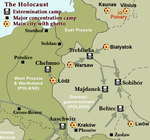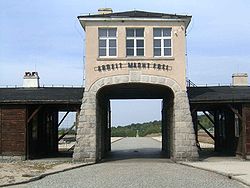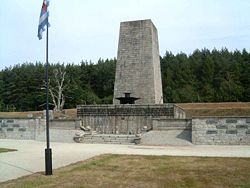
Gross-Rosen concentration camp
Encyclopedia



Germany
Germany , officially the Federal Republic of Germany , is a federal parliamentary republic in Europe. The country consists of 16 states while the capital and largest city is Berlin. Germany covers an area of 357,021 km2 and has a largely temperate seasonal climate...
concentration camp, located in Gross-Rosen, Lower Silesia
Lower Silesia
Lower Silesia ; is the northwestern part of the historical and geographical region of Silesia; Upper Silesia is to the southeast.Throughout its history Lower Silesia has been under the control of the medieval Kingdom of Poland, the Kingdom of Bohemia and the Austrian Habsburg Monarchy from 1526...
(now Rogoźnica
Rogoznica, Lower Silesian Voivodeship
Rogoźnica is a village in the administrative district of Gmina Strzegom, within Świdnica County, Lower Silesian Voivodeship, in south-western Poland. Prior to 1945 it was part of Poland, Bohemia, Austria, Prussia and Germany....
, Poland
Poland
Poland , officially the Republic of Poland , is a country in Central Europe bordered by Germany to the west; the Czech Republic and Slovakia to the south; Ukraine, Belarus and Lithuania to the east; and the Baltic Sea and Kaliningrad Oblast, a Russian exclave, to the north...
). It was located directly on the rail line between Jauer (now Jawor)
Jawor
Jawor is a town in south-western Poland with 24,347 inhabitants . It is situated in Lower Silesian Voivodeship . It is the seat of Jawor County, and lies approximately west of the regional capital Wrocław.In the town can be found a Protestant Church of Peace...
and Striegau (now Strzegom)
Strzegom
Strzegom is a town in Świdnica County, Lower Silesian Voivodeship, in south-western Poland. It is the seat of the administrative district called Gmina Strzegom. It lies approximately north-west of Świdnica, and west of the regional capital Wrocław...
.
The camp
It was set up in the summer of 1940 as a satellite camp to SachsenhausenSachsenhausen concentration camp
Sachsenhausen or Sachsenhausen-Oranienburg was a Nazi concentration camp in Oranienburg, Germany, used primarily for political prisoners from 1936 to the end of the Third Reich in May, 1945. After World War II, when Oranienburg was in the Soviet Occupation Zone, the structure was used as an NKVD...
, and became an independent camp on May 1, 1941. Initially, work was carried out in the camp's huge stone quarry, owned by the SS-Deutsche Erd- und Steinwerke GmbH (SS German Earth and Stone Works). As the complex grew, many inmates were put to work in the construction of the subcamps' facilities.
In October 1941 the SS transferred about 3,000 Soviet POWs to Gross-Rosen for execution by shooting.
Gross-Rosen was known for its brutal treatment of NN (Nacht und Nebel
Nacht und Nebel
Nacht und Nebel was a directive of Adolf Hitler on 7 December 1941 signed and implemented by Armed Forces High Command Chief Wilhelm Keitel, resulting in the kidnapping and forced disappearance of many political activists and resistance 'helpers' throughout Nazi Germany's occupied...
) prisoners, especially in the stone quarry. The brutal treatment of the political and Jewish prisoners was not only due to the SS and criminal prisoners, but to a lesser extent also due to German civilians working in the stone quarry. In 1942, for political prisoners, the mean survival time was less than two months.
Due to a change of policy in August 1942, prisoners were likely to survive longer because they were needed as slave workers in German industries. Among the companies that benefited from the slave labour of the concentration camp inmates were German electronics manufacturers such as Blaupunkt
Blaupunkt
GmbH is a German manufacturer of electronics equipment, noted for its home and car audio equipment. It was a 100% subsidiary of Robert Bosch GmbH until March 1st, 2009 when its Aftermarket and Accessories branch including the brand name were sold to Aurelius AG of Germany for an undisclosed...
or Siemens
Siemens
Siemens may refer toSiemens, a German family name carried by generations of telecommunications industrialists, including:* Werner von Siemens , inventor, founder of Siemens AG...
. Some prisoners who were not able to work and not yet dying within a few days, were sent to Dachau
Dachau
Dachau is a town in Upper Bavaria, in the southern part of Germany. It is a major district town—a Große Kreisstadt—of the administrative region of Upper Bavaria, about 20 km north-west of Munich. It is now a popular residential area for people working in Munich with roughly 40,000 inhabitants...
in so-called invalid transports. One of these, Willem Lodewijk Harthoorn, an inmate from the end of April to mid-August 1942, wrote an account of his experiences, Verboden te sterven (in Dutch, meaning Forbidden to Die). The largest population of inmates, however, were Jews, initially from the Dachau and Sachsenhausen camps, and later from Buchenwald. During the camp's existence, the Jewish inmate population came mainly from Poland and Hungary; others were from Belgium, France, Netherlands, Greece, Yugoslavia, Slovakia, and Italy.
At its peak activity in 1944, the Gross-Rosen complex had up to sixty subcamps located in eastern Germany and occupied Poland. In its final stage, the population of the Gross-Rosen camps accounted for 11% of the total inmates in Nazi concentration camps at that time. A total of 125,000 inmates of various nationalities passed through the complex during its existence, of whom an estimated 40,000 died on site and in evacuation transports. The camp was liberated on February 14, 1945, by the Red Army
Red Army
The Workers' and Peasants' Red Army started out as the Soviet Union's revolutionary communist combat groups during the Russian Civil War of 1918-1922. It grew into the national army of the Soviet Union. By the 1930s the Red Army was among the largest armies in history.The "Red Army" name refers to...
.
A total of over 500 female camp guards were trained and served in the Gross Rosen complex. Female SS staffed the women's subcamps of Brünnlitz, Graeben, Gruenberg, Gruschwitz Neusalz, Hundsfeld, Kratzau II, Oberalstadt, Reichenbach
Reichenbach
- In Germany :* Reichenbach , in the Niederschlesischer Oberlausitzkreis district, Saxony* Reichenbach im Vogtland, in the Vogtlandkreis district, Saxony* Reichenbach am Heuberg, in the Tuttlingen district, Baden-Württemberg...
, and Schlesiersee Schanzenbau.
A subcamp of Gross-Rosen situated in the Czechoslovakia
Czechoslovakia
Czechoslovakia or Czecho-Slovakia was a sovereign state in Central Europe which existed from October 1918, when it declared its independence from the Austro-Hungarian Empire, until 1992...
n town of Brünnlitz was a location where Jews rescued by Oskar Schindler
Oskar Schindler
Oskar Schindler was an ethnic German industrialist born in Moravia. He is credited with saving over 1,100 Jews during the Holocaust by employing them in his enamelware and ammunitions factories, which were located in what is now Poland and the Czech Republic respectively.He is the subject of the...
were interned.
Camp commandants
During the Gross-Rosen period as a subcamp of SachsenhausenSachsenhausen concentration camp
Sachsenhausen or Sachsenhausen-Oranienburg was a Nazi concentration camp in Oranienburg, Germany, used primarily for political prisoners from 1936 to the end of the Third Reich in May, 1945. After World War II, when Oranienburg was in the Soviet Occupation Zone, the structure was used as an NKVD...
the following SS-officers served as Lagerführer:
- SS-UntersturmführerUntersturmführerUntersturmführer was a paramilitary rank of the German Schutzstaffel first created in July 1934. The rank can trace its origins to the older SA rank of Sturmführer which had existed since the founding of the SA in 1921...
- Anton Thumann - SS-UntersturmführerUntersturmführerUntersturmführer was a paramilitary rank of the German Schutzstaffel first created in July 1934. The rank can trace its origins to the older SA rank of Sturmführer which had existed since the founding of the SA in 1921...
- Georg Gussregen
As an independent concentration camp from May 1941, the following were commandants:
- SS-ObersturmbannführerObersturmbannführerObersturmbannführer was a paramilitary Nazi Party rank used by both the SA and the SS. It was created in May 1933 to fill the need for an additional field grade officer rank above Sturmbannführer as the SA expanded. It became an SS rank at the same time...
- Arthur RodlArthur RödlArthur Rödl was a German Standartenführer in the Waffen-SS and a Nazi concentration camp commandant....
, May 1941- September 1942 - SS-HauptsturmführerHauptsturmführerHauptsturmführer was a Nazi rank of the SS which was used between the years of 1934 and 1945. The rank of Hauptsturmführer was a mid-grade company level officer and was the equivalent of a Captain in the German Army and also the equivalent of captain in foreign armies...
- Wilhelm GideonWilhelm GideonWilhelm Gideon was a German Schutzstaffel officer and Nazi concentration camp commandant....
, September 1942 - October 1943 - SS-SturmbannführerSturmbannführerSturmbannführer was a paramilitary rank of the Nazi Party equivalent to major, used both in the Sturmabteilung and the Schutzstaffel...
- Johannes HassebroekJohannes HassebroekJohannes Hassebroeck was a German Schutzstaffel officer and Nazi concentration camp commandant.-Early years:...
, October 1943 - until evacuation
See also
- List of Nazi-German concentration camps
- List of subcamps of Gross Rosen
- Project RieseProject RieseFile:Project Riese - map.PNG|thumb|right|495px|Project Riese. Click on the locations to see details.rect 81 48 88 55 rect 171 248 178 255 rect 241 219 248 226 rect 235 235 242 242 rect 204 247 211 254 rect 260 241 267 248 rect 234 271 241 278...

